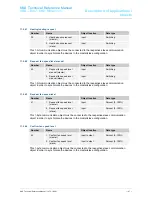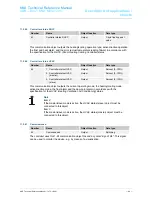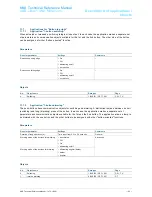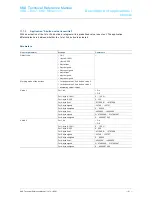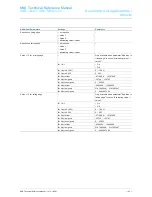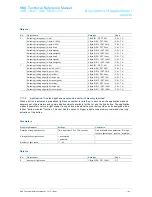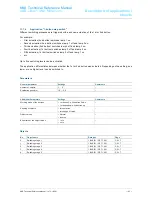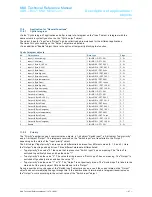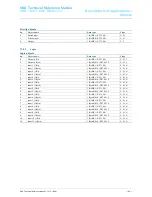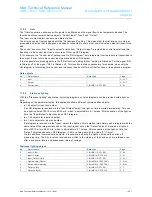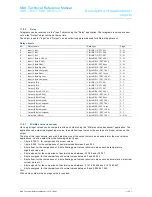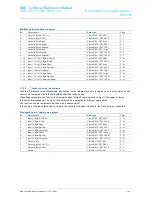
KNX Technical Reference Manual
ABB-i-Bus
®
-KNX Millenium
Description of applications /
objects
KNX Technical Reference Manual | 1473-1-8681
— 100 —
Pos: 31.35 /Layout bis 2014-11-11/Online-Dokumentation (+KNX)/Überschriften (--> Für alle Dokumente <--)/3. Ebene/U - Z/Verzögerung @ 41\mod_1422541098275_15.docx @ 331620 @ 2 @ 1
11.8.6
Delay
Pos: 31.36 /Layout bis 2014-11-11/Online-Hilfe/Power-Tool/Power-Tool 2/chm-Online-Hilfe/App/Verzoegerung/App. - Verzögerung - DIN-A4 @ 9\mod_1269508848356_15.docx @ 53088 @ @ 1
Telegrams can be received via the "Input" object using the "Delay" application. The telegrams received are sent
out on the "Output" object with a set delay time.
The object types for "Input" and "Output" can be collectively parameterised for different applications.
Delay objects
No.
Object name
Data type
Flags
0
Input (1 Bit)
1 Bit EIS1 / DPT 1.001
C, W
0
Input (1 Bit)
1 Bit EIS7 / DPT 1.008
C, W
0
Input (1 Bit)
1 Bit EIS7 / DPT 1.007
C, W
0
Input (1 Byte 0..100 %)
1 Byte EIS6 / DPT 5.001
C, W
0
Input (1 Byte 0..255)
1 Byte EIS14 / DPT 5.010
C, W
0
Input (2 Byte Float)
2 Byte EIS5 / DPT 9.xxx
C, W
0
Input (2 Byte Signed)
2 Byte EIS10 / DPT 8.001
C, W
0
Input (2 Byte Unsigned)
2 Byte EIS10 / DPT 7.001
C, W
0
Input (4 Byte Float)
4 Byte EIS9 / DPT 14.xxx
C, W
0
Input (4 Byte Signed)
4 Byte EIS11 / DPT 13.001
C, W
0
Input (4 Byte Unsigned)
4 Byte EIS11 / DPT 12.001
C, W
1
Output (1 Bit)
1 Bit EIS1 / DPT 1.001
C, T
1
Output (1 Bit)
1 Bit EIS7 / DPT 1.008
C, T
1
Output (1 Bit)
1 Bit EIS7 / DPT 1.007
C, T
1
Output (1 Byte 0..100 %)
1 Byte EIS6 / DPT 5.001
C, T
1
Output (1 Byte 0..255)
1 Byte EIS14 / DPT 5.010
C, T
1
Output (2 Byte Float)
2 Byte EIS5 / DPT 9.xxx
C, T
1
Output (2 Byte Signed)
2 Byte EIS10 / DPT 7.001
C, T
1
Output (2 Byte Unsigned)
2 Byte EIS10 / DPT 7.001
C, T
1
Output (4 Byte Float)
4 Byte EIS9 / DPT 14.xxx
C, T
1
Output (4 Byte Signed)
4 Byte EIS11 / DPT 13.001
C, T
1
Output (4 Byte Unsigned)
4 Byte EIS11 / DPT 12.001
C, T
2
Delay time (2 Byte)
2 Byte EIS10 / DPT 7.001
C, R, W
Pos: 31.37 /Layout bis 2014-11-11/Online-Dokumentation (+KNX)/Überschriften (--> Für alle Dokumente <--)/3. Ebene/M - O/Min- / Maxwertgeber @ 41\mod_1422541161503_15.docx @ 331637 @ 2 @ 1
11.8.7
Min/Max value transducer
Pos: 31.38 /Layout bis 2014-11-11/Online-Hilfe/Power-Tool/Power-Tool 2/chm-Online-Hilfe/App/MinMax/App. - Min- / Maxwertgeber - DIN-A4 @ 10\mod_1269512210610_15.docx @ 53189 @ @ 1
Up to eight input values can be compared with each other using the "Min/max value transducer" application. The
application can output the highest input value, the smallest input value or the average of all input values on the
output.
The size of the input objects, and with it also the size of the output object can be adapted for the most diverse
applications. You can select from the following object types:
– 1-byte 0..100 %, for comparison of percent values
– 1-byte 0..255, for the comparison of decimal values between 0 and 255
– 2-byte float, for the comparison of 2-byte floating point values (physical values such as temperature,
brightness value etc.)
– 2-byte signed, for the comparison of decimal values between -32,768 and +32,767
– 2-byte unsigned, for the comparison of decimal values between 0 and 65,535
– 4-byte float, for the comparison of 4-byte floating point values (physical values such as acceleration, electrical
current, work etc.)
– 4-byte signed, for the comparison of decimal values between -2,147,483,648 and 2,147,483,647
– 4-byte unsigned, for the comparison of decimal values between 0 and 4,294,967,295
Hint:
With whole numbers the average value is rounded.


